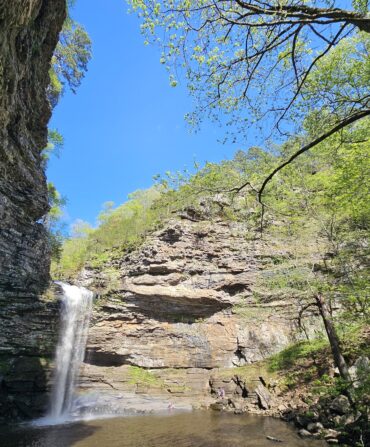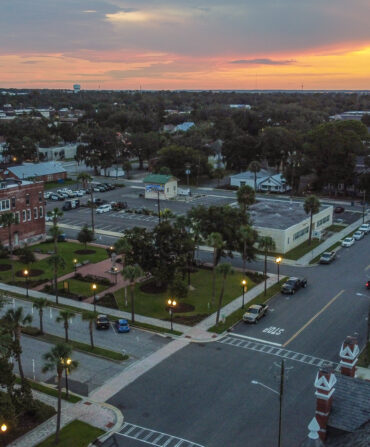It is said in the army that West Virginians make the best drivers because anyone who can master the state’s roller-coaster roads can drive anywhere in the world. What better place to baptize my eighteen-year-old daughter, Grace, into the ways of the mountain road than on a winding two-lane highway that also takes us back to our family roots? U.S. Route 250 runs northwest from Richmond, Virginia, through Hundred, West Virginia, where my great-aunt and great-uncle, Varena and Tub, lived.
Two-fifty was built on an old Indian trail marked by three notches carved into trees along the route. I grew up in Richmond on Three Chopt Road, once part of that trail. The first time I drove myself to see Aunt Varena and Uncle Tub, who used to send me a shiny Kennedy half-dollar on every birthday, my father told me, “Take a left off the lane and don’t stop until you get to the last house in Hundred.” For me, the 320-odd miles in between the two houses—rolling roads through woods, farm country, hills, and mountains—were a wrinkle in time.
At Varena and Tub’s modest house beside 250, an albino deer regularly descended from the woods to drink from Varena’s goldfish pond, dug in the shape of West Virginia. She swore that her goldfish froze solid every winter and thawed again in the spring. Directly across 250, Tub kept hogs in a pen outfitted with a front porch, a rocker, and a hand-rigged phone line to the house so he could talk to Varena.
Though the old homestead is no more and Varena and Tub have passed on, I was excited to revisit the well-worn path with Grace last summer. From our home in Richmond, we navigated the unsightly urban sprawl that has sprung up in the decades since I first traveled to Varena and Tub’s. But we soon left it behind as we sped through the rolling pastures west of town. We made our first stop at Spudnut in Charlottesville, one of the few remaining Southern outposts of a 1940s potato-flour doughnut empire, where we gobbled down orange and blueberry cake doughnuts—denser and tastier than their wheat-flour cousins. Fuel for the byway.
We cruised through the charming town of Crozet, named after Claudius Crozet, the engineer who orchestrated the construction of 250 and whom Thomas Jefferson called “the best mathematician in the United States.” Once a sleepy railroad town amid orchards, Crozet is now a sophisticated Charlottesville bedroom community with its own craft suds (Starr Hill Brewery) and cuvées (King Family Vineyards).
The real fun, though, started after Staunton, on the section of 250 known as the Staunton-Parkersburg Turnpike—a twisting, turning ribbon of history through the Appalachians. Built before the Civil War to link the Shenandoah Valley to the Ohio River (and much fought over by Confederate and Union troops), the historic highway was the first over-mountain route through the Allegheny stretch of the Appalachians and in its day a marvel of engineering. After crossing the deep woods of the George Washington National Forest, just past the town of Monterey, we pulled over in Hightown and climbed on top of a fence post at a stony pasture that has always transported me back in time, like a daguerreotype, with its simple rugged beauty. This is where twenty-plus years ago I had spirited off Grace’s mother—my wife, Jessica—to propose to her. Howling with laughter, Grace and I posed for selfies, maneuvering as if playing Twister to get both of our faces on the screen, along with the swooping split-rail fence behind us.
Eight miles later, we crossed into the West Virginia Allegheny Mountains. The passes here are so narrow and steep that driving them is a whole mind and body experience. As you lean into the curves, you hug the centerlines to keep from feeling like you’re in the whirling teacups at the county fair. What matters is the rock wall on one side and the plunge on the other. This was Grace’s initiation.
Rounding curves, climbing, and dropping, scanning for fallen rocks and dashing deer, maintaining or checking her speed, Grace was totally dialed in. Not that she got the hang of it right off. She was almost always braking and accelerating at the wrong times.
Watching her, I realized that it’s all about anticipation and not reaction; by the time you react, it’s too late. “You want to tap on the brakes before you hit the curve and accelerate out of it,” I reminded her. Grace had to pull aside several times for speedier hill surfers to pass by. That was okay. She was learning, and best of all, she didn’t chicken out.
We took a break at the Hermitage Motel, a two-story motor court at a crossroads called Bartow on a fork of the Greenbrier River, where my family used to meet my grandparents to drop off the latest baby while the rest of the brood went to the beach. The old place now sits in ruins, for sale to the highest bidder, so I couldn’t introduce Grace to the Hermitage’s chocolate cream pie, which my sisters and I deemed the best in two states. But you can still cool your feet in the icy trout stream that runs beside and curves behind the once proud roadside haven.
Several mountains later, Grace pulled us into Helvetia, our final stop on this trip. The unself-consciously quaint village was settled by Swiss farmers just after the Civil War and is where Jessica and I had spent the weekend after I proposed. Forty minutes off 250 in a dense forest of rhododendron and hardwoods, it’s the remotest populated place I have been to in the eastern part of the country. Despite the fact that the Swiss were swindled into buying lush-looking but worthless farmland, they remained and, in their own way, thrived, preserving their culture without caricature for generations. There’s Swiss dining at the Hütte Restaurant; an Alpine-style inn beside a babbling stream; local honey, jams, jellies, and pastries for sale at the Honey Haus; and a handful of events involving alpenhorns, yodeling, square dancing, and Fahnenshwingen (flag swinging)—things at which the proud locals are still expert.
At dusk, Grace and I rested our feet on the porch at the inn and sipped homemade lemonade, wondering at the tenacity of Helvetia. That’s what it takes to live—or even just to drive—in these hills. You can’t chicken out.







